BRITISH COAT OF ARMS The main

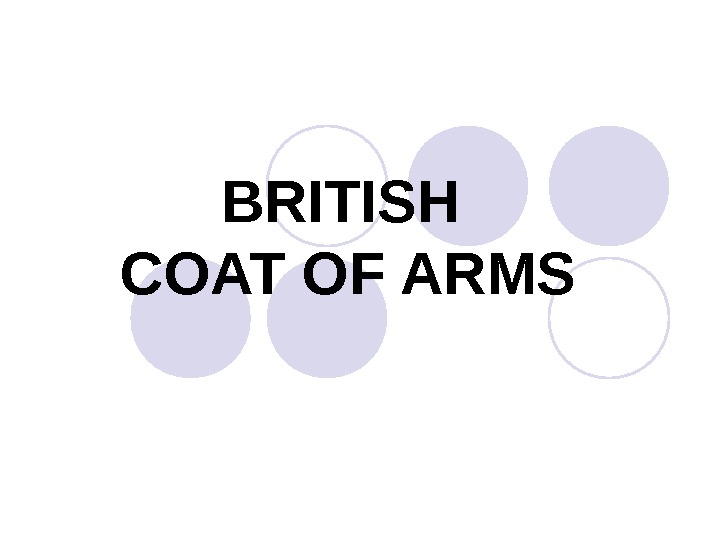
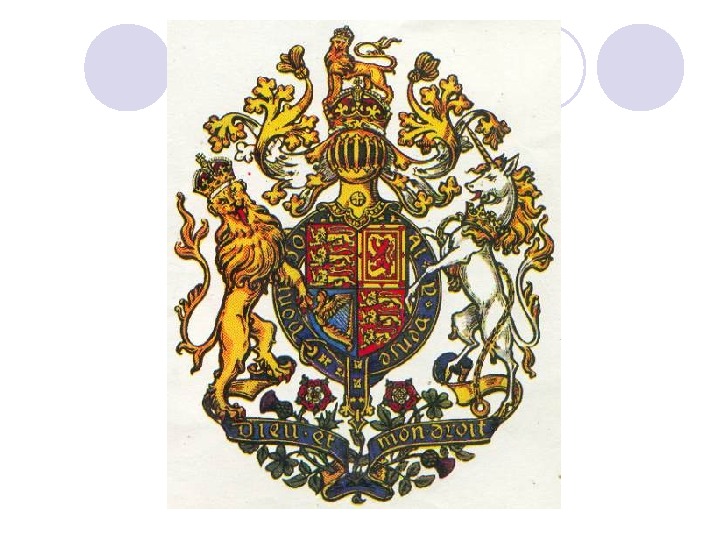

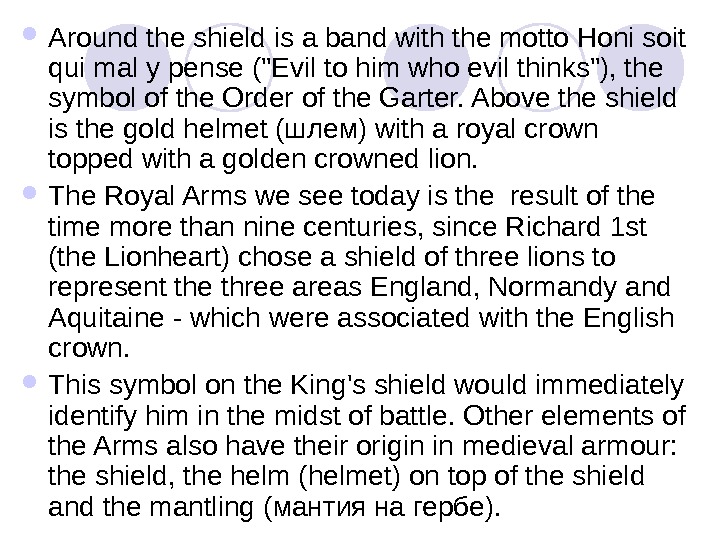
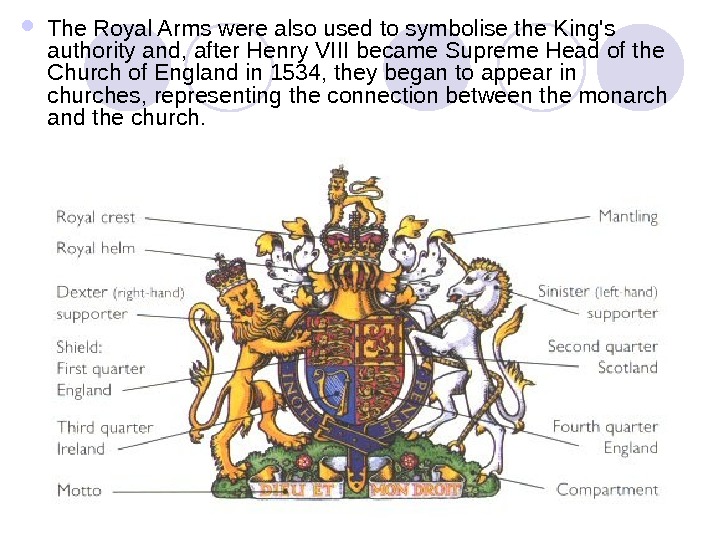
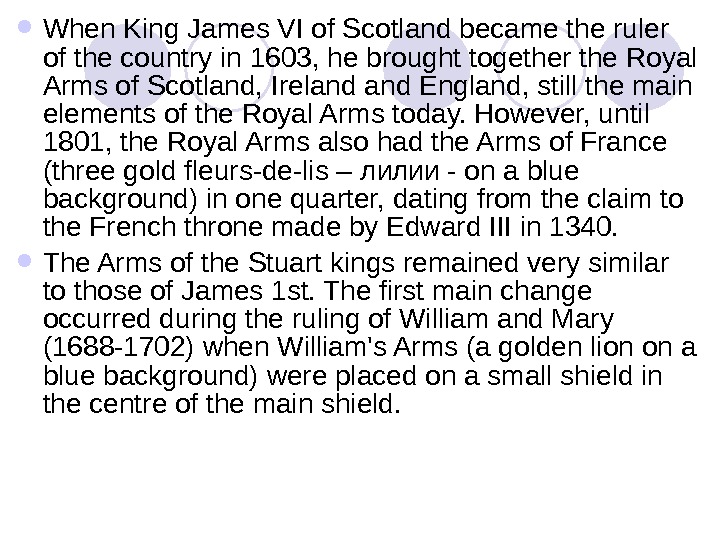
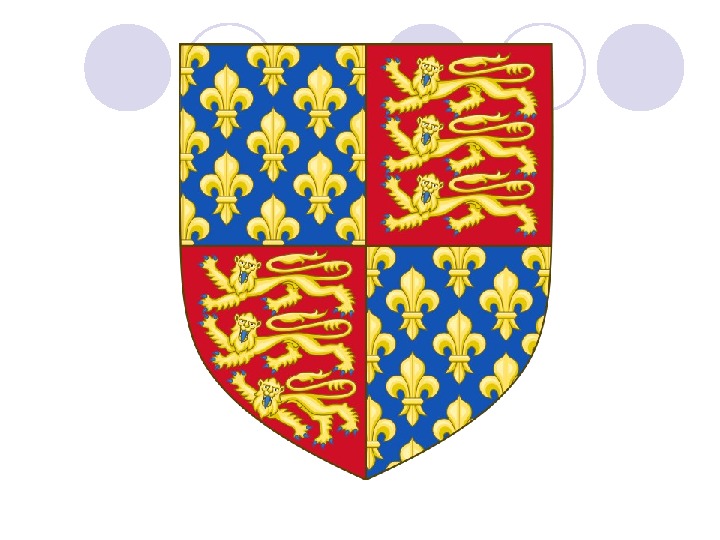
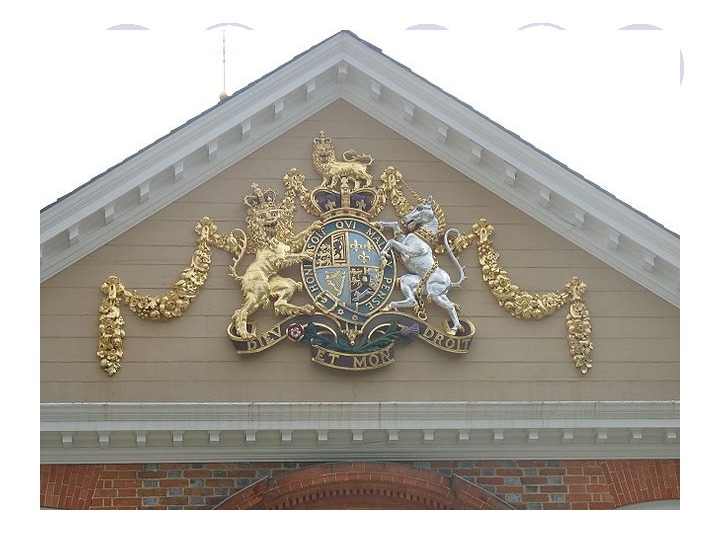

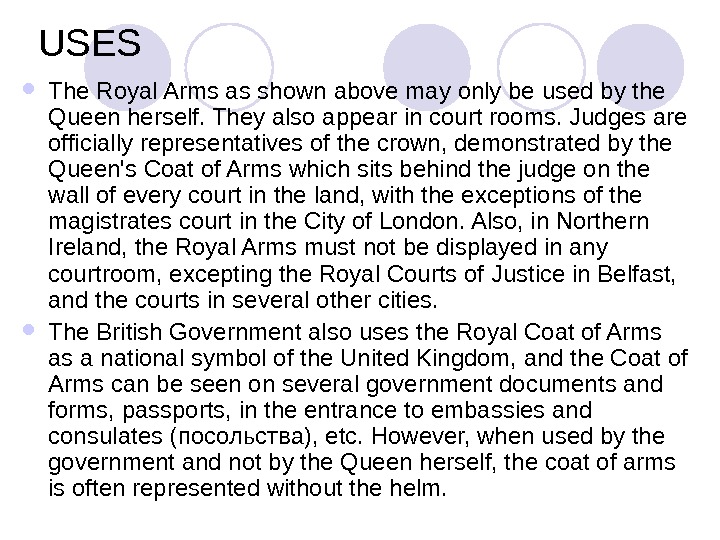
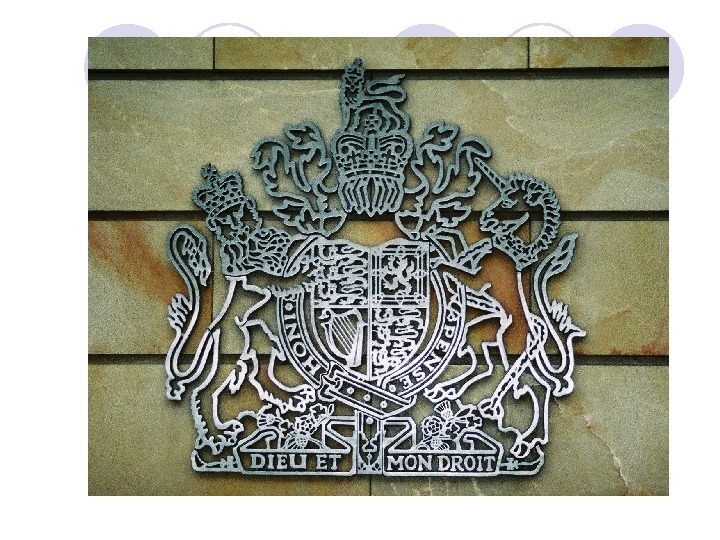
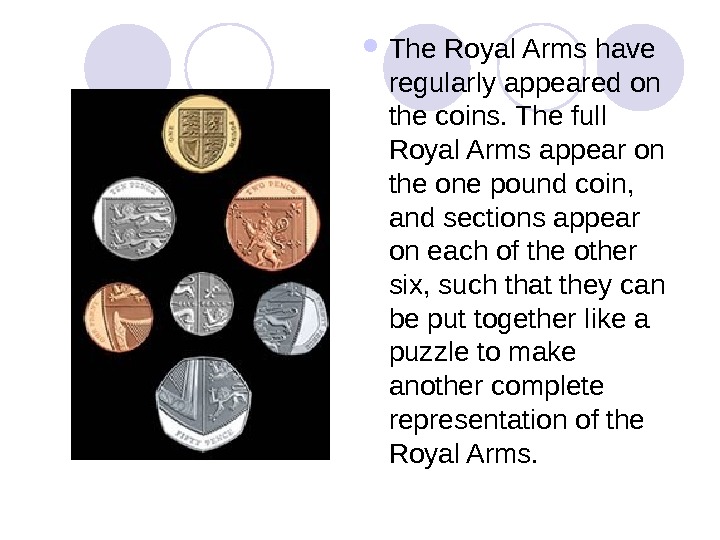
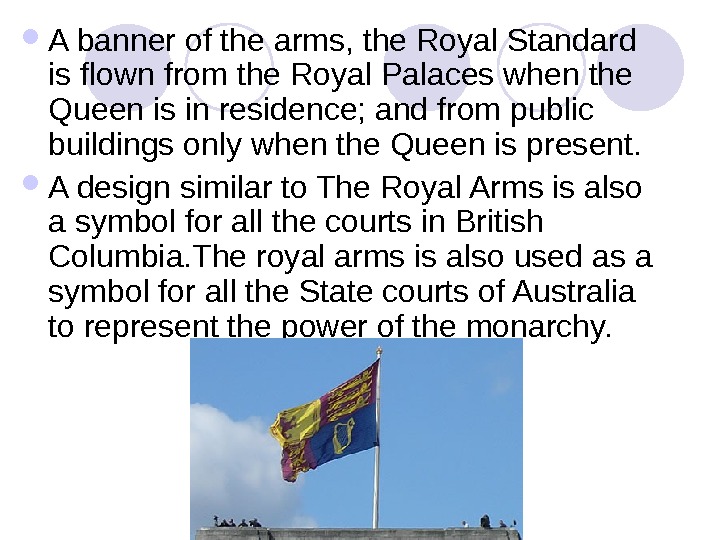
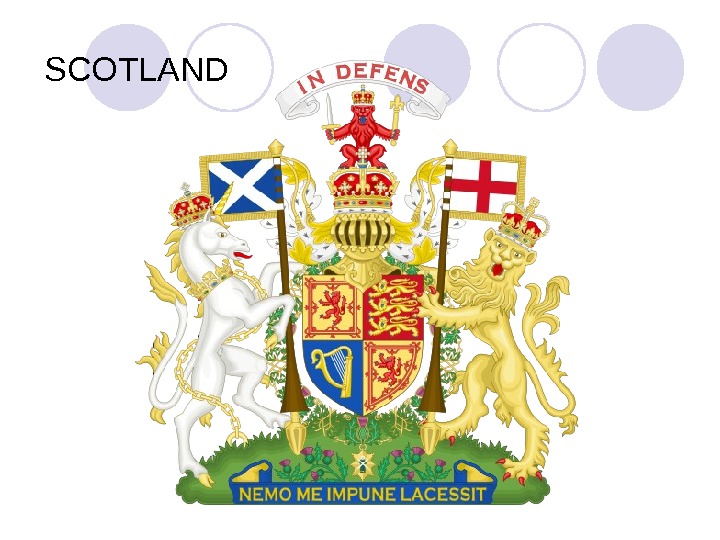
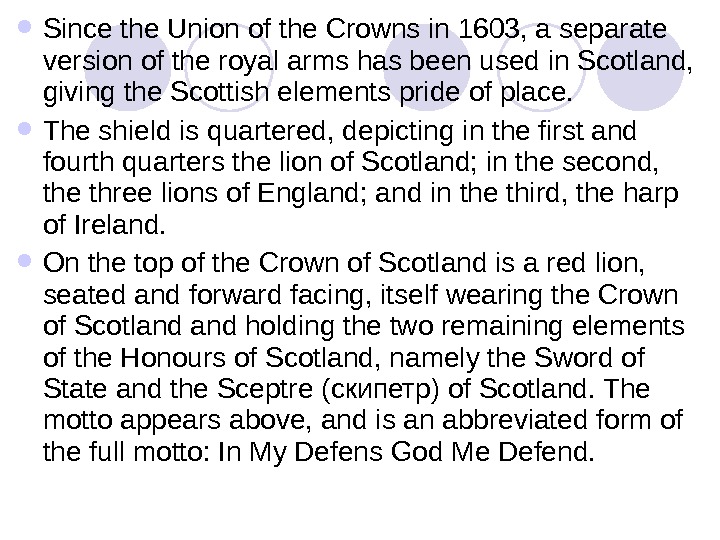
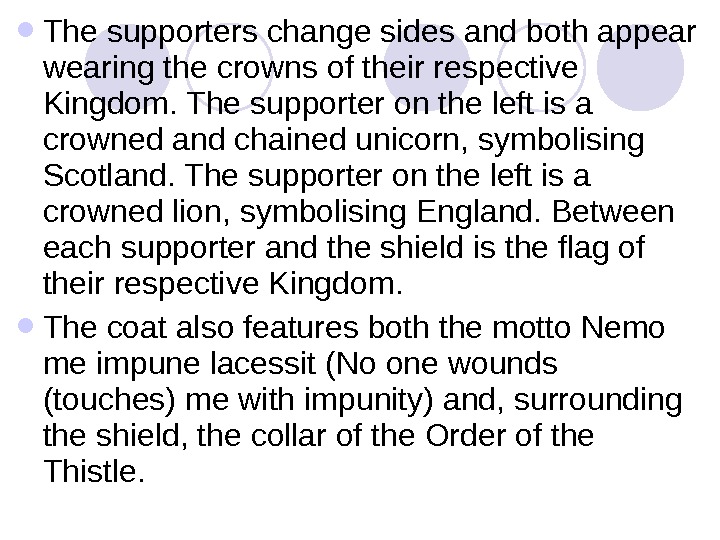

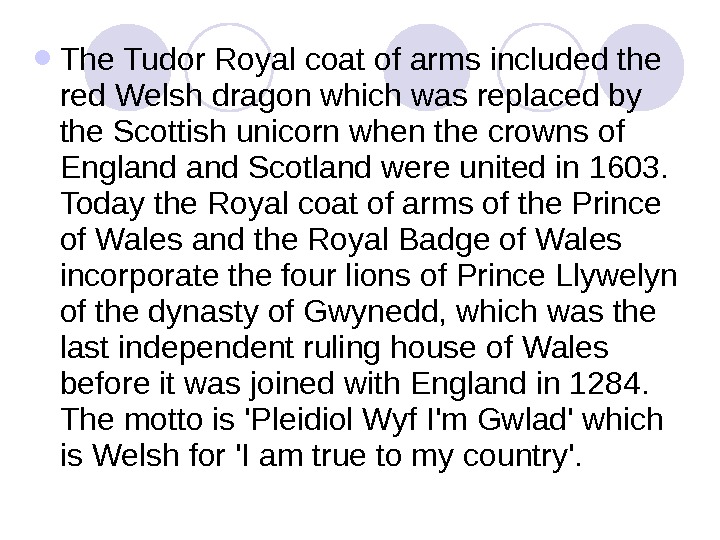
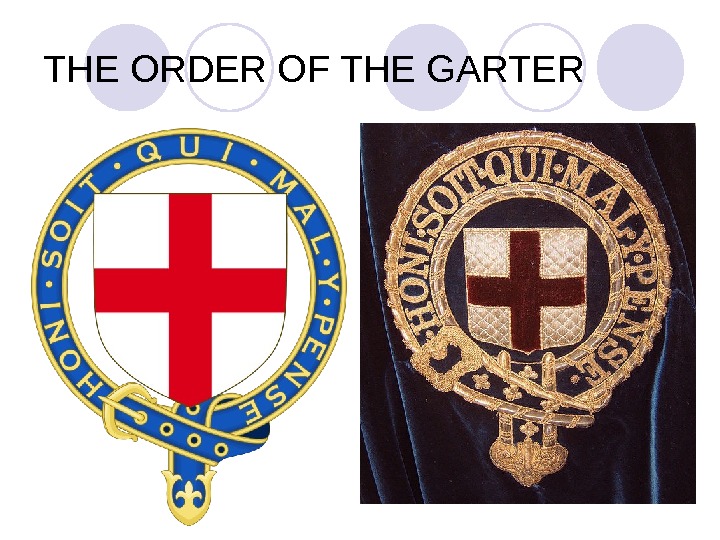
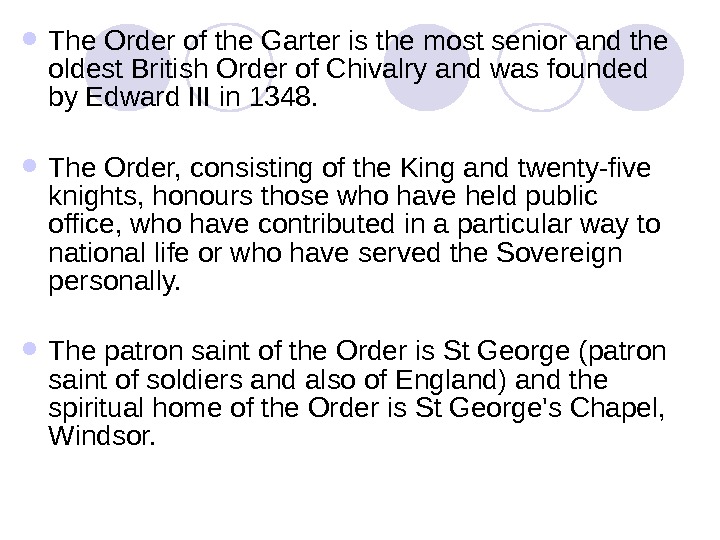
- Размер: 2 Mегабайта
- Количество слайдов: 20
Описание презентации BRITISH COAT OF ARMS The main по слайдам
 BRITISH COAT OF ARMS
BRITISH COAT OF ARMS

 The main element of the Royal Arms is the shield which is divided into four quarters. The three golden lions on a red background, symbolising England, occupy the first and fourth quarters. The Arms of Scotland, a red lion rearing on its hind legs inside a red border, are in the second quarter, and the Arms of Ireland’s golden harp (золотая арфа) with silver strings on a blue background — are in the third quarter. The lion and the unicorn supporting the shield represent England Scotland. The unicorn has a chain around him because during the medieval times unicorns were believed to be very dangerous beasts. They stand on a small frame called the compartment which includes the plant emblems of Scotland (thistle), Ireland (shamrock) and England (rose). The Compartment also has the queen’s motto Dieu et mon droit («God and my right»).
The main element of the Royal Arms is the shield which is divided into four quarters. The three golden lions on a red background, symbolising England, occupy the first and fourth quarters. The Arms of Scotland, a red lion rearing on its hind legs inside a red border, are in the second quarter, and the Arms of Ireland’s golden harp (золотая арфа) with silver strings on a blue background — are in the third quarter. The lion and the unicorn supporting the shield represent England Scotland. The unicorn has a chain around him because during the medieval times unicorns were believed to be very dangerous beasts. They stand on a small frame called the compartment which includes the plant emblems of Scotland (thistle), Ireland (shamrock) and England (rose). The Compartment also has the queen’s motto Dieu et mon droit («God and my right»).
 Around the shield is a band with the motto Honi soit qui mal y pense («Evil to him who evil thinks»), the symbol of the Order of the Garter. Above the shield is the gold helmet (шлем) with a royal crown topped with a golden crowned lion. The Royal Arms we see today is the result of the time more than nine centuries, since Richard 1 st (the Lionheart) chose a shield of three lions to represent the three areas England, Normandy and Aquitaine — which were associated with the English crown. This symbol on the King’s shield would immediately identify him in the midst of battle. Other elements of the Arms also have their origin in medieval armour: the shield, the helm (helmet) on top of the shield and the mantling ( мантия на гербе ).
Around the shield is a band with the motto Honi soit qui mal y pense («Evil to him who evil thinks»), the symbol of the Order of the Garter. Above the shield is the gold helmet (шлем) with a royal crown topped with a golden crowned lion. The Royal Arms we see today is the result of the time more than nine centuries, since Richard 1 st (the Lionheart) chose a shield of three lions to represent the three areas England, Normandy and Aquitaine — which were associated with the English crown. This symbol on the King’s shield would immediately identify him in the midst of battle. Other elements of the Arms also have their origin in medieval armour: the shield, the helm (helmet) on top of the shield and the mantling ( мантия на гербе ).
 The Royal Arms were also used to symbolise the King’s authority and, after Henry VIII became Supreme Head of the Church of England in 1534, they began to appear in churches, representing the connection between the monarch and the church.
The Royal Arms were also used to symbolise the King’s authority and, after Henry VIII became Supreme Head of the Church of England in 1534, they began to appear in churches, representing the connection between the monarch and the church.
 When King James VI of Scotland became the ruler of the country in 1603, he brought together the Royal Arms of Scotland, Ireland England, still the main elements of the Royal Arms today. However, until 1801, the Royal Arms also had the Arms of France (three gold fleurs-de-lis – лилии — on a blue background) in one quarter, dating from the claim to the French throne made by Edward III in 1340. The Arms of the Stuart kings remained very similar to those of James 1 st. The first main change occurred during the ruling of William and Mary (1688 -1702) when William’s Arms (a golden lion on a blue background) were placed on a small shield in the centre of the main shield.
When King James VI of Scotland became the ruler of the country in 1603, he brought together the Royal Arms of Scotland, Ireland England, still the main elements of the Royal Arms today. However, until 1801, the Royal Arms also had the Arms of France (three gold fleurs-de-lis – лилии — on a blue background) in one quarter, dating from the claim to the French throne made by Edward III in 1340. The Arms of the Stuart kings remained very similar to those of James 1 st. The first main change occurred during the ruling of William and Mary (1688 -1702) when William’s Arms (a golden lion on a blue background) were placed on a small shield in the centre of the main shield.


 The Union with Scotland in 1707 was marked by placing the Arms of England those of Scotland side by side in the first and fourth quarters. The fleurs-de-lis of France took over the whole second quarter, and Ireland’s harp the third. George 1 st in 1714 made further changes to include his territories. The English and Scottish lions remained side by side in the first quarter, but were replaced by a completely new coat of Arms divided into three, in the fourth quarter, showing two golden lions on a red field, a blue lion on a gold background and in the lowest part a galloping white horse on a red background. This is often the easiest feature to identify from a distance. The Act of Union with Ireland in 1801 caused a further change, with the Arms of England, Scotland Ireland placed in the quarters where we see them today and the dropping of the French Arms. The final significant changes occurred when Victoria became Queen in 1837. The Royal Arms have remained the same ever since.
The Union with Scotland in 1707 was marked by placing the Arms of England those of Scotland side by side in the first and fourth quarters. The fleurs-de-lis of France took over the whole second quarter, and Ireland’s harp the third. George 1 st in 1714 made further changes to include his territories. The English and Scottish lions remained side by side in the first quarter, but were replaced by a completely new coat of Arms divided into three, in the fourth quarter, showing two golden lions on a red field, a blue lion on a gold background and in the lowest part a galloping white horse on a red background. This is often the easiest feature to identify from a distance. The Act of Union with Ireland in 1801 caused a further change, with the Arms of England, Scotland Ireland placed in the quarters where we see them today and the dropping of the French Arms. The final significant changes occurred when Victoria became Queen in 1837. The Royal Arms have remained the same ever since.
 USES The Royal Arms as shown above may only be used by the Queen herself. They also appear in court rooms. Judges are officially representatives of the crown, demonstrated by the Queen’s Coat of Arms which sits behind the judge on the wall of every court in the land, with the exceptions of the magistrates court in the City of London. Also, in Northern Ireland, the Royal Arms must not be displayed in any courtroom, excepting the Royal Courts of Justice in Belfast, and the courts in several other cities. The British Government also uses the Royal Coat of Arms as a national symbol of the United Kingdom, and the Coat of Arms can be seen on several government documents and forms, passports, in the entrance to embassies and consulates ( посольства ), etc. However, when used by the government and not by the Queen herself, the coat of arms is often represented without the helm.
USES The Royal Arms as shown above may only be used by the Queen herself. They also appear in court rooms. Judges are officially representatives of the crown, demonstrated by the Queen’s Coat of Arms which sits behind the judge on the wall of every court in the land, with the exceptions of the magistrates court in the City of London. Also, in Northern Ireland, the Royal Arms must not be displayed in any courtroom, excepting the Royal Courts of Justice in Belfast, and the courts in several other cities. The British Government also uses the Royal Coat of Arms as a national symbol of the United Kingdom, and the Coat of Arms can be seen on several government documents and forms, passports, in the entrance to embassies and consulates ( посольства ), etc. However, when used by the government and not by the Queen herself, the coat of arms is often represented without the helm.

 The Royal Arms have regularly appeared on the coins. The full Royal Arms appear on the one pound coin, and sections appear on each of the other six, such that they can be put together like a puzzle to make another complete representation of the Royal Arms.
The Royal Arms have regularly appeared on the coins. The full Royal Arms appear on the one pound coin, and sections appear on each of the other six, such that they can be put together like a puzzle to make another complete representation of the Royal Arms.
 A banner of the arms, the Royal Standard is flown from the Royal Palaces when the Queen is in residence; and from public buildings only when the Queen is present. A design similar to The Royal Arms is also a symbol for all the courts in British Columbia. The royal arms is also used as a symbol for all the State courts of Australia to represent the power of the monarchy.
A banner of the arms, the Royal Standard is flown from the Royal Palaces when the Queen is in residence; and from public buildings only when the Queen is present. A design similar to The Royal Arms is also a symbol for all the courts in British Columbia. The royal arms is also used as a symbol for all the State courts of Australia to represent the power of the monarchy.
 SCOTLAN
SCOTLAN
 Since the Union of the Crowns in 1603, a separate version of the royal arms has been used in Scotland, giving the Scottish elements pride of place. The shield is quartered, depicting in the first and fourth quarters the lion of Scotland; in the second, the three lions of England; and in the third, the harp of Ireland. On the top of the Crown of Scotland is a red lion, seated and forward facing, itself wearing the Crown of Scotland holding the two remaining elements of the Honours of Scotland, namely the Sword of State and the Sceptre ( скипетр ) of Scotland. The motto appears above, and is an abbreviated form of the full motto: In My Defens God Me Defend.
Since the Union of the Crowns in 1603, a separate version of the royal arms has been used in Scotland, giving the Scottish elements pride of place. The shield is quartered, depicting in the first and fourth quarters the lion of Scotland; in the second, the three lions of England; and in the third, the harp of Ireland. On the top of the Crown of Scotland is a red lion, seated and forward facing, itself wearing the Crown of Scotland holding the two remaining elements of the Honours of Scotland, namely the Sword of State and the Sceptre ( скипетр ) of Scotland. The motto appears above, and is an abbreviated form of the full motto: In My Defens God Me Defend.
 The supporters change sides and both appear wearing the crowns of their respective Kingdom. The supporter on the left is a crowned and chained unicorn, symbolising Scotland. The supporter on the left is a crowned lion, symbolising England. Between each supporter and the shield is the flag of their respective Kingdom. The coat also features both the motto Nemo me impune lacessit (No one wounds (touches) me with impunity) and, surrounding the shield, the collar of the Order of the Thistle.
The supporters change sides and both appear wearing the crowns of their respective Kingdom. The supporter on the left is a crowned and chained unicorn, symbolising Scotland. The supporter on the left is a crowned lion, symbolising England. Between each supporter and the shield is the flag of their respective Kingdom. The coat also features both the motto Nemo me impune lacessit (No one wounds (touches) me with impunity) and, surrounding the shield, the collar of the Order of the Thistle.
 WALES
WALES
 The Tudor Royal coat of arms included the red Welsh dragon which was replaced by the Scottish unicorn when the crowns of England Scotland were united in 1603. Today the Royal coat of arms of the Prince of Wales and the Royal Badge of Wales incorporate the four lions of Prince Llywelyn of the dynasty of Gwynedd, which was the last independent ruling house of Wales before it was joined with England in 1284. The motto is ‘Pleidiol Wyf I’m Gwlad’ which is Welsh for ‘I am true to my country’.
The Tudor Royal coat of arms included the red Welsh dragon which was replaced by the Scottish unicorn when the crowns of England Scotland were united in 1603. Today the Royal coat of arms of the Prince of Wales and the Royal Badge of Wales incorporate the four lions of Prince Llywelyn of the dynasty of Gwynedd, which was the last independent ruling house of Wales before it was joined with England in 1284. The motto is ‘Pleidiol Wyf I’m Gwlad’ which is Welsh for ‘I am true to my country’.
 THE ORDER OF THE GARTER
THE ORDER OF THE GARTER
 The Order of the Garter is the most senior and the oldest British Order of Chivalry and was founded by Edward III in 1348. The Order, consisting of the King and twenty-five knights, honours those who have held public office, who have contributed in a particular way to national life or who have served the Sovereign personally. The patron saint of the Order is St George (patron saint of soldiers and also of England) and the spiritual home of the Order is St George’s Chapel, Windsor.
The Order of the Garter is the most senior and the oldest British Order of Chivalry and was founded by Edward III in 1348. The Order, consisting of the King and twenty-five knights, honours those who have held public office, who have contributed in a particular way to national life or who have served the Sovereign personally. The patron saint of the Order is St George (patron saint of soldiers and also of England) and the spiritual home of the Order is St George’s Chapel, Windsor.

